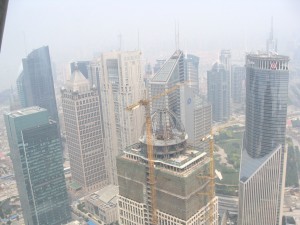Beijing Blog Part 6: On a midnight train to Shanghai
June 6, 2009-(D301 Night Train – Somewhere between Beijing and Shanghai)
An hour and a half outside the city of Shanghai, the barren, flat landscape of rural China suddenly turns into the factories and high rises of modern industry. 30 minutes later, and you can see nothing but towering skyscraper apartments and construction cranes, working to build the next new tower, the next new office building, the next new construction effort.
Welcome to Shanghai.

A view of Shanghai-Pudong from the Oriental Pearl television tower 256 meters in the air. 15 years ago, this area was undeveloped farmland.
I guess my blog is a little misleading since it’s called the “Beijing Blog” but Shanghai is the second leg of the tour of China that my mom and I are currently traveling. But why Shanghai?
One look outside the window will reveal the biggest reason why Shanghai is always second on the list of any international traveler when visiting China. The roaring landscape immediately tells you just how industry and growth has spurred on a new kind of China. Not a China based on the Cultural Revolution, but a China based on a mixed feeling of capitalism and a mixed feeling of the old Communist ways.
This new growth mixed with old ideas is the confliction that’s going to change China in the near future. And it’s exactly that confliction that makes China such an interesting place to be at this time and place.

The four-person sleeper car that we used to go from Beijing to Shanghai. China's high speed mag-lev rail system makes it so that you can go from one city to another at over 300 km/hr.
In reality, there’s no better place to see that growth than Shanghai itself. When companies battle to do trade in China, it’s always in Shanghai. Not only is it a port city, which makes goods and international trade viable, but it’s also the center of China’s industries itself. It’s carmakers, it’s semiconductor companies, it’s heavy industries, any company in China usually headquarters itself in Shanghai; the business capital of the world.
The train stops for a moment at Changzhou, then continues racing towards the sea, eager to get to Shanghai. The train is also a new experience. It’s a night train, so most of the cars are soft-sleepers, or sleeper cars. Our particular room had four beds, which one way from Beijing to Shanghai cost about 720 RMB ($105 US). The train may be much more expensive than a plane in China, but the views are breathtaking. And besides, even though I don’t understand what they’re saying, the kung fu drama on the tv they give us is also kind of amusing too.
Looks like the train gradually slowing down, that’s also my cue that my time writing to you guys is nearly up. Until next time, Isshin Teshima, signing out from Shanghai.




No comments.
Comments are currently closed. Comments are closed on all posts older than one year, and for those in our archive.